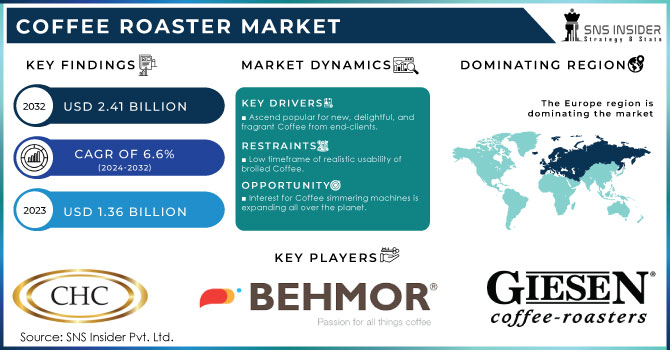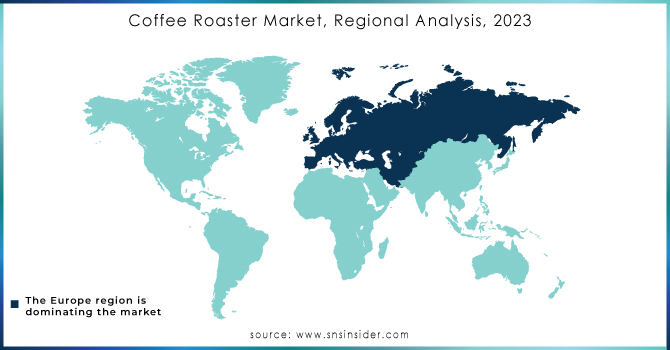Coffee Roaster Market Report Scope & Overview:

Get More Information on Coffee Roaster Market - Request Sample Report
The Coffee Roaster Market Size was valued at USD 1.36 billion in 2023 and is expected to reach USD 2.41 billion by 2032, and grow at a CAGR of 6.6% over the forecast period 2024-2032.
Coffee simmering machines are utilized to change the physical and compound properties of green Coffee beans into cooked Coffee items with change in taste, variety, thickness, and smell. Green Coffee beans, or unroasted beans, have acids, protein, and caffeine like the broiled ones yet need taste. The Coffee cooking machine produces various kinds of Coffee beans, for example, light dish Coffee beans, medium dish Coffee beans, and dull dish Coffee beans. The primary reason for an Coffee cooking machine is to acquire various kinds of Coffee. The worldwide Coffee cooking machines market has been growing extensively throughout the previous few decades. It is assessed to extend at a consistent speed sooner rather than later.
Coffee roasters are accessible in an assortment of structures and sizes, and they are generally used in business foodservice tasks. Homegrown interest for medium and little size Coffee Roasters has expanded as the preference for home-blended Coffee has developed. Coffee Roasters are popular as individuals' inclinations for caffeine-based items develop all over the planet. The Global Coffee Roaster Market has developed because of expanded populace and rising tendency for non-cocktails.
Market Dynamics:
Driving Factors:
-
Ascend popular for new, delightful, and fragrant Coffee from end-clients.
-
Expansion in deals in Coffee bistros.
Restraining Factors:
-
Low timeframe of realistic usability of broiled Coffee.
-
Maximum usage of tea when contrasted with that of Coffee.
Opportunities:
-
Interest for Coffee simmering machines is expanding all over the planet.
-
Ascend in interest in home broiling is projected to fuel the interest for Coffee simmering machines in homes sooner rather than later.
Challenges:
-
Discharge of harmful gases.
-
Particulate matter during the cooking system.
Impact of Covid-19:
The COVID-19 emergency had made deals volumes of Coffee decline around by 48-half in Europe and an expected 23-25% in the United States, affecting Coffee roasters' providers, as providers are requesting less Coffee roasters from merchants, and stockrooms are practically full.
Moreover, the lockdown and social removing measures have caused a decrease in Coffee utilization. This especially influences limited scope Coffee roasters and roasters who predominantly supply to lodgings, cafés, and bistros (HORECA), this area detailed a 75-80% decrease.
Market Estimations:
Coffee has portioned their market into three particular client fragments:
Cafés/drive-through eateries/trucks: These clients are buying Coffee beans for the planning and offer of Coffee and coffee based drinks. Their foundations serve a wide assortment of Coffee and coffee refreshments to clients that visit the cafés, drive-through eateries, or truck based servers.
Cafés: These foundations are buying Coffee and coffee to serve to their retail food clients.
Supermarkets: These clients are buying the beans for either prepackaged, or mass, resale to their clients. The food merchants don't set up the beverages for the clients like the other client fragments, they just sell the Beanisimo item as is bought from Beanisimo Coffee.
Key Market Segmentation:
By Product Type:
-
Classic drum roasters
-
Hot air roasters
-
Centrifugal roasters
-
Others (tangential roasters, etc.)
By Capacity:
-
Up to 10 kg
-
10 kg to 30 kg
-
30 kg to 50 kg
-
Above 50 kg
By Control:
-
Automatic
-
Manual
By Heat Source:
-
Electric
-
Gas
By Procurement:
-
New
-
Used
By Material (Body):
-
Stainless
-
Cast Iron
By Application:
-
Residential
-
Commercial
-
Cafes and Cafeteria
-
Hotels and Restaurants
-
Others (Offices, etc.)
-
Industrial
By Price:
-
Low
-
Medium
-
High
By Distribution Channel:
-
Direct
-
Indirect
Regional Analysis:
-
North America
-
The USA
-
Canada
-
Mexico
-
-
Europe
-
Germany
-
The UK
-
France
-
Italy
-
Spain
-
The Netherlands
-
Rest of Europe
-
-
Asia-Pacific
-
Japan
-
south Korea
-
China
-
India
-
Australia
-
Rest of Asia-Pacific
-
-
The Middle East & Africa
-
Israel
-
UAE
-
South Africa
-
Rest of Middle East & Africa
-
-
Latin America
-
Brazil
-
Argentina
-
Rest of Latin America
-
As far as topography, the worldwide Coffee broiling machines market can be isolated into North America, Europe, Asia Pacific, Middle East and Africa, and South America
Europe is supposed to overwhelm the worldwide Coffee broiling machine market during the estimate time frame. Ascend in the quantity of Coffee outlets and the interest for the new cooked Coffee is high in the locale. It is normal to fuel the interest for Coffee cooking machine during the gauge time frame.

Need any customization research on Coffee Roaster Market - Enquiry Now
Key Players:
Key Players of Roasted coffee maker markets are Coffee Holding Company, Inc., Hottop, Behmor, Inc., Giesen Coffee Roasters, US Roaster Corp, Vending Sense Group Ltd, Beanworks, Coffed Coffee Roasters, SM-Service Ltd., ACM
| Report Attributes | Details |
|---|---|
| Market Size in 2023 | USD 1.36 Billion |
| Market Size by 2032 | USD 2.41 Billion |
| CAGR | CAGR 6.6% From 2024 to 2032 |
| Base Year | 2023 |
| Forecast Period | 2024-2032 |
| Historical Data | 2020-2022 |
| Report Scope & Coverage | Market Size, Segments Analysis, Competitive Landscape, Regional Analysis, DROC & SWOT Analysis, Forecast Outlook |
| Key Segments | • by Product Type (Drum, Hot Air, Stove Top, and Other Product Types) • by Category (Electric and Gas Roasters) • by End User (Industrial, Commercial, and Household |
| Regional Analysis/Coverage | North America (USA, Canada, Mexico), Europe (Germany, UK, France, Italy, Spain, Netherlands, Rest of Europe), Asia-Pacific (Japan, South Korea, China, India, Australia, Rest of Asia-Pacific), The Middle East & Africa (Israel, +D11UAE, South Africa, Rest of Middle East & Africa), Latin America (Brazil, Argentina, Rest of Latin America) |
| Company Profiles | Coffee Holding Company, Inc., Hottop, Behmor, Inc., Giesen Coffee Roasters, US Roaster Corp, Vending Sense Group Ltd, Beanworks, Coffed Coffee Roasters, SM-Service Ltd., ACM |
| Key Drivers | •Ascend popular for new, delightful, and fragrant Coffee from end-clients. •Expansion in deals in Coffee bistros. |
| Market Challenges: | •Discharge of harmful gases. •Particulate matter during the cooking system. |

